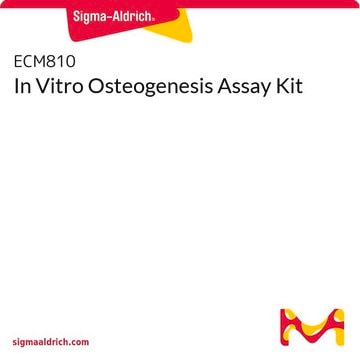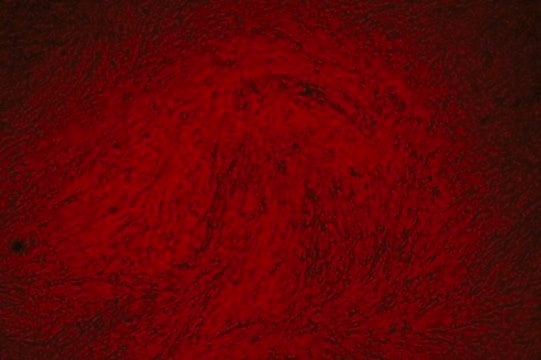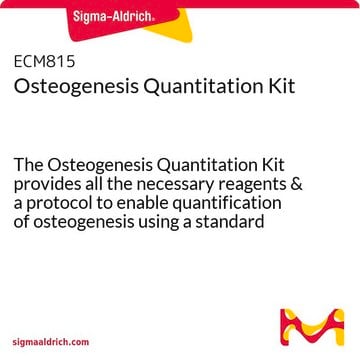SCR028
Mesenchymal Stem Cell Osteogenesis Kit
The Mesenchymal Stem Cell Osteogenesis Kit contains all the reagents necessary to readily differentiate mesenchymal stem cells to an osteogenic lineage as assessed by Alizarin Red staining.
About This Item
おすすめの製品
品質水準
メーカー/製品名
Chemicon®
テクニック
cell culture | stem cell: suitable
入力
sample type mesenchymal stem cell(s)
検出方法
colorimetric
輸送温度
wet ice
詳細
Stem cell technology, particularly embryonic stem cells and/or mesenchymal stem cells, offer attractive sources of osteoblasts for tissue culture studies and for the biochemical dissection of the earliest steps involved in osteoblast cell determination. Mesenchymal stem cells are multipotent progenitor cells that have the capacity to differentiate into several mesenchymal cell lineages, including bone, cartilage and fat.
CHEMICON®′s Mesenchymal Stem Cell Osteogenesis Kit contains all the reagents necessary to readily differentiate mesenchymal stem cells to an osteogenic lineage as assessed by Alizarin Red staining. Reagents in the kit include two ECM coating molecules (collagen Type I and vitronectin) that have been shown to promote osteogenic differentiation of mesenchymal stem cells (Salasznyk, 2004) along with inducing reagents, dexamethasone, ascorbic acid 2-phosphate and b-glycerophosphate. Also included is Alizarin Red Solution, a staining solution that is used to detect the presence of calcium in bone.
Using CHEMICON′s Mesenchymal Stem Cell Osteogenesis Kit, we typically obtain >50% mature osteocytes from rat bone marrow derived mesenchymal stem cells. Efficiency of osteogenic differentiation may vary, depending upon the quality of the mesenchymal stem cells and if variations to the protocol are introduced.
For Research Use Only; not for use in diagnostic procedure.
アプリケーション
幹細胞研究
構成
Ascorbic Acid 2-Phosphate Solution: (Catalog No. 2004011) One vial containing 500 μL of 100 mM ascorbic acid 2-phosphate in water. Store at -20°C.
Glycerol 2- Phosphate Solution: (Catalog No. 2004010) Three vials containing 1 mL of 1 M glycerol 2-phosphate in water. Store at -20°C.
Collagen, Type I: (Catalog No. 2004013) One vial containing 150 μg collagen Type I. Store at -20°C.
Vitronectin: (Catalog No. 2004012) One vial containing 150 μg vitronectin. Store at -20°C.
Alizarin Red Solution: (Catalog No. 2003999) One bottle containing 50 mL Alizarin Red Solution. Store at 2° to 8°C.
保管および安定性
Dexamethasone Solution, Ascorbic Acid 2-Phosphate Solution, Glycerol 2- Phosphate Solution, Collagen Type I, and Vitronectin should be stored at -20ºC. Alizarin Red Solution should be stored at 2° to 8°C.
Precautions
· Dexamethasone is an irritant and potentially toxic. DMSO is readily absorbed through the skin. Wear a lab coat and gloves when handling these solutions.
Please refer to the Material Safety Data Sheet at www.chemicon.com for further precautions.
法的情報
免責事項
シグナルワード
Danger
危険有害性情報
危険有害性の分類
Eye Irrit. 2 - Flam. Liq. 2 - Repr. 1B - STOT SE 2
ターゲットの組織
Eyes,Central nervous system
保管分類コード
3 - Flammable liquids
引火点(°F)
48.2 °F
引火点(℃)
9 °C
適用法令
試験研究用途を考慮した関連法令を主に挙げております。化学物質以外については、一部の情報のみ提供しています。 製品を安全かつ合法的に使用することは、使用者の義務です。最新情報により修正される場合があります。WEBの反映には時間を要することがあるため、適宜SDSをご参照ください。
毒物及び劇物取締法
キットコンポーネントの情報を参照してください
PRTR
キットコンポーネントの情報を参照してください
消防法
キットコンポーネントの情報を参照してください
労働安全衛生法名称等を表示すべき危険物及び有害物
キットコンポーネントの情報を参照してください
労働安全衛生法名称等を通知すべき危険物及び有害物
キットコンポーネントの情報を参照してください
カルタヘナ法
キットコンポーネントの情報を参照してください
Jan Code
キットコンポーネントの情報を参照してください
試験成績書(COA)
製品のロット番号・バッチ番号を入力して、試験成績書(COA) を検索できます。ロット番号・バッチ番号は、製品ラベルに「Lot」または「Batch」に続いて記載されています。
この製品を見ている人はこちらもチェック
アクティブなフィルタ
ライフサイエンス、有機合成、材料科学、クロマトグラフィー、分析など、あらゆる分野の研究に経験のあるメンバーがおります。.
製品に関するお問い合わせはこちら(テクニカルサービス)














